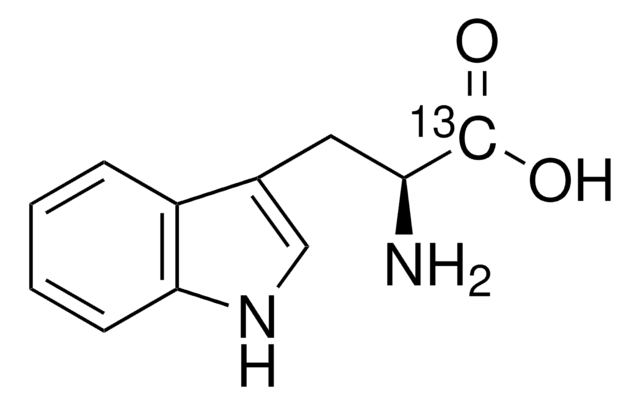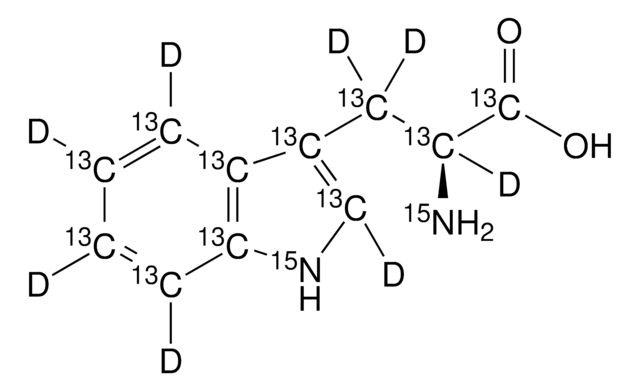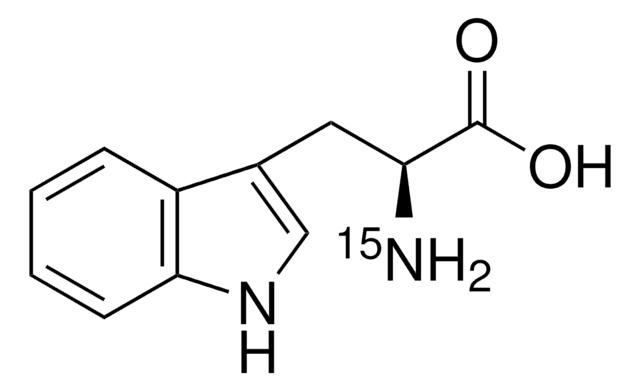All Photos(1)
About This Item
Empirical Formula (Hill Notation):
C11H13N3O · HCl
CAS Number:
Molecular Weight:
239.70
EC Number:
MDL number:
UNSPSC Code:
12352200
PubChem Substance ID:
Recommended Products
Assay
≥98% (TLC)
form
powder
color
white to off-white
SMILES string
Cl.N[C@@H](Cc1c[nH]c2ccccc12)C(N)=O
InChI
1S/C11H13N3O.ClH/c12-9(11(13)15)5-7-6-14-10-4-2-1-3-8(7)10;/h1-4,6,9,14H,5,12H2,(H2,13,15);1H/t9-;/m0./s1
InChI key
WOBDANBSEWOYKN-FVGYRXGTSA-N
Storage Class Code
11 - Combustible Solids
WGK
WGK 3
Flash Point(F)
Not applicable
Flash Point(C)
Not applicable
Personal Protective Equipment
dust mask type N95 (US), Eyeshields, Gloves
Choose from one of the most recent versions:
Already Own This Product?
Find documentation for the products that you have recently purchased in the Document Library.
Cássia Alessandra Marquezin et al.
Biopolymers, 71(5), 569-576 (2003-11-25)
We present results of time resolved fluorescence measurements performed in Tryptophan (Trp) derivatives and Trp-containing peptides in the pH range 3.0-11.0. For each compound a set of decay profiles measured in a given range of pH values was examined as
D Andrews et al.
European journal of biochemistry, 146(1), 201-209 (1985-01-02)
When tryptophanyl-tRNA synthetase from Escherichia coli is allowed to react with L-tryptophan and ATP-Mg in the presence of inorganic pyrophosphatase, the fluorescence change of the reaction mixture reveals three or four sequential processes, depending on the buffer used. Quenched-flow and
Krishanu Ray et al.
The journal of physical chemistry. C, Nanomaterials and interfaces, 112(46), 17957-17963 (2009-01-31)
In recent years metal-enhanced fluorescence (MEF) using silver particles has been reported for a number of fluorophores emitting at visible wavelengths. However it was generally thought that silver particles would always quench fluorescence at shorter wavelengths. We now report the
Roy W Alston et al.
Biophysical journal, 94(6), 2280-2287 (2007-12-11)
This article probes the denatured state ensemble of ribonuclease Sa (RNase Sa) using fluorescence. To interpret the results obtained with RNase Sa, it is essential that we gain a better understanding of the fluorescence properties of tryptophan (Trp) in peptides.
D Pörschke et al.
Nucleic acids research, 10(19), 6163-6176 (1982-10-11)
The amides of L-phenylalanine, L-tyrosine and L-tryptophane decrease the melting temperatures tm of poly(A)*poly(U) and poly(I)*poly(C) double helices at low concentrations (1 mM), whereas high concentrations finally lead to an increase of tm. This dependence of the tm-values upon the
Our team of scientists has experience in all areas of research including Life Science, Material Science, Chemical Synthesis, Chromatography, Analytical and many others.
Contact Technical Service






